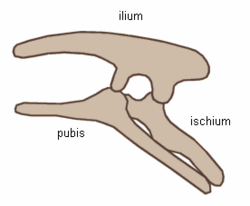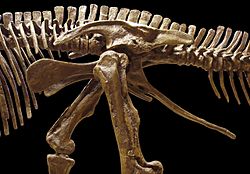Ornithischia facts for kids
Quick facts for kids OrnithischiaTemporal range: Upper Triassic–Upper Cretaceous, 228–65 mya
|
|
|---|---|
 |
|
| Ornithischian pelvic structure (left side) | |
| Scientific classification | |
| Kingdom: | |
| Phylum: | |
| Class: | |
| Superorder: | |
| Order: |
Ornithischia
Seeley, 1888
|

Ornithischia (say: Or-nih-THISH-kee-uh) is a group of plant-eating dinosaurs. They are often called 'bird-hipped' dinosaurs because of the special shape of their hips. It's a bit confusing, though, because modern birds actually came from the 'lizard-hipped' dinosaurs, called Saurischia.
Another name for this group is Predentata. This name comes from a unique bone they all share: a special beak-like bone at the front of their lower jaw. This bone, called a 'predentary', helped them snip off plants to eat. The upper part of their beak was formed by the 'premaxilla' bone. This beak was a super important tool for these plant-eating dinosaurs to get their food.
Many of the first ornithischians walked on two legs, which is called bipedal. But very early in their history, they learned to walk on both two legs and four legs (quadrupedal). Over time, some groups of ornithischians even became completely quadrupedal, meaning they always walked on all four legs.
The Ornithischia group is divided into two main types:
- Thyreophora: These were the armored dinosaurs, like the spiky Stegosaurs and the heavily protected Ankylosaurs.
- Cerapoda: This group includes the famous duck-billed dinosaurs and the horned dinosaurs.
Contents
What Makes Ornithischians Unique?
Ornithischian dinosaurs are known for a few key features that set them apart from other dinosaurs. Their most famous trait is their hip structure. Unlike the 'lizard-hipped' dinosaurs, the ornithischians had a hip bone called the pubis that pointed backwards, running alongside another hip bone called the ischium. This is similar to the hip structure of modern birds.
Another unique feature is the 'predentary' bone. This extra bone was at the very front of their lower jaw. It worked with the 'premaxilla' bone in their upper jaw to form a strong, sharp beak. This beak was perfect for cutting and stripping tough plant material, making them very efficient herbivores.
Types of Bird-Hipped Dinosaurs
The Ornithischia group is very diverse, meaning it includes many different kinds of dinosaurs. Here are some of the main families you might know:
Armored Dinosaurs: Thyreophora
This group includes dinosaurs that had bony plates or spikes on their bodies for protection.
- Stegosauria: These dinosaurs are famous for the large, upright plates along their backs and a spiked tail that they used for defense. Stegosaurus is a well-known example.
- Ankylosauria: Often called "living tanks," these dinosaurs were covered in thick, bony armor. Many also had a heavy club at the end of their tail, which they could swing to protect themselves from predators.
Duck-Billed and Horned Dinosaurs: Cerapoda
This is another large and varied group within Ornithischia.
- Ornithopoda: This group includes the famous duck-billed dinosaurs, like Parasaurolophus and Edmontosaurus. They often lived in large herds and had complex chewing abilities to grind down plants. Some ornithopods could walk on two legs or four.
- Marginocephalia: This group is split into two main types:
- Pachycephalosauria: These dinosaurs are known for their incredibly thick, dome-shaped skulls. Scientists think they might have used their heads for head-butting, perhaps in fights over territory or mates.
- Ceratopsia: This group includes the horned dinosaurs, like Triceratops. They had large frills around their necks and horns on their faces, which they likely used for defense against predators and for showing off to other dinosaurs.
Where Did They Live?
Ornithischian dinosaurs lived all over the world, from the Upper Triassic period (about 228 million years ago) all the way to the end of the Upper Cretaceous period (about 65 million years ago). This means they were around for a very long time, adapting to many different environments before the dinosaurs died out. Their fossils have been found on every continent, showing how successful and widespread they were.
See also
 In Spanish: Ornitisquios para niños
In Spanish: Ornitisquios para niños
Images for kids












